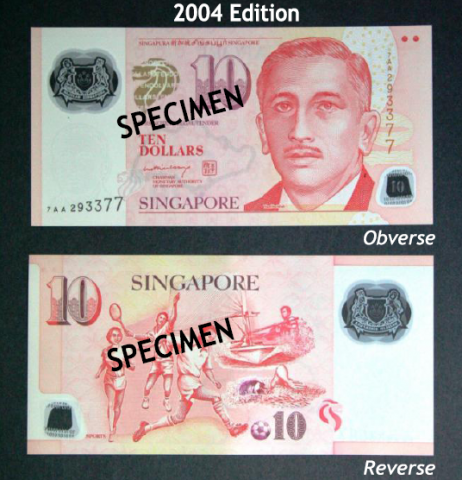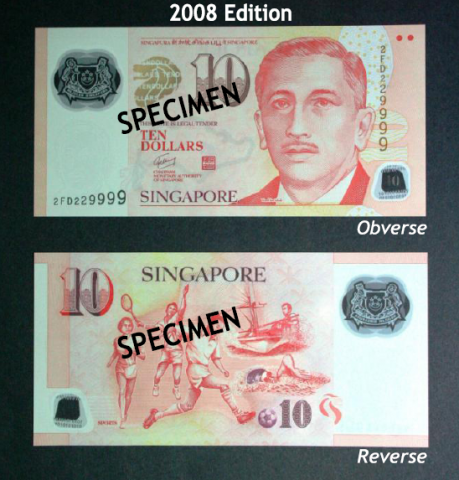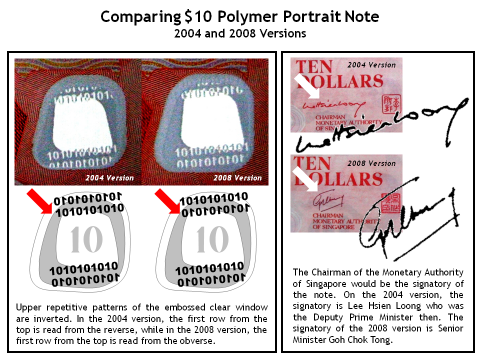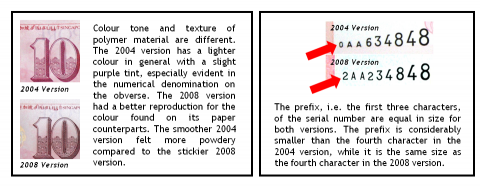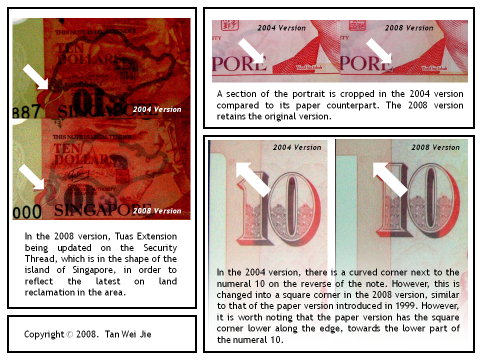Today’s article published in The Straits Times entitled ‘Take note: It’s not fake’ pointed out that the ‘lighter-coloured $10 bills are from (the) first polymer batch in 2004’. This was to clarify the existence of such notes with a lighter tone and to urge those in the sales sector to accept them as legal tender.
I have written the following in February 2008, a few weeks after the release of the new banknotes.
The new series of S$10 polymer notes were released in late January 2008, bearing the signature of the Chairman of the Monetary Authority of Singapore (MAS), Goh Chok Tong. This was a move after the success of introducing the first batch of 10 million polymer notes to determine the suitability of using such notes in Singapore.
On 30th April 2004, the MAS announced the introduction of a new $10 Polymer Portrait Note on 4 May 2004. The new polymer notes have a design similar to the paper version, with some additional features unique to polymer technology. This is to preserve the public familiarity of the notes, as well as to minimise any alterations to note handling machines. The Portrait Series was launched on 9 September 1999 to welcome the new millennium.
The serial numbers for the first edition of the $10 polymer note had prefixes from 0AA to 9AA, then from 0AB to 2AB. The prefix 9AA was supposed to be the last of the series, but the error rate was so high that it went on all the way to 2AB. Banknotes that were misprinted were not replaced by a ‘replacement note’. Instead, this note is removed from the stack automatically by the machine, thus accounting for the jumps in serial numbers in uncirculated stacks of banknotes.
The first edition of the note, signed by the former Chairman of the MAS, Deputy Prime Minister Lee Hsien Loong, has the same dimensions as its paper counterpart. The 2004 edition is printed by Note Printing Australia (NPA), which has also printed the commemorative $20 note released in 2007 to mark the 40th anniversary of the currency interchangeability agreement between Brunei Darussalam and Singapore.
A limited edition folder of 10,000 sets worldwide was issued with notes bearing the prefix ‘MAS’, with a limit of not more than two sets per customer. A special overprint commemorates this first note issue of the MAS.
To protect the interest of our currency, I have included some of the more notable differences between the 2004 polymer notes and 2008 polymer notes. Please note that the following are just my observations under close scrutiny, and was done back in February 2008. There are other minor differences which were found between the two batches of banknotes as well.
Serial number for illustration purposes only.
Perhaps, these variations, together with the mysterious symbols found on our banknotes, would spark some interest in note collecting.
